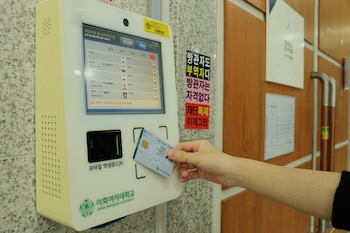
Electronic attendance systems has tripled in universities in the last two years.
Prior to the electronic system, professors would manually call attendance, or hire a teaching assistant to do so. Universities have since eliminated this extremely time consuming process through the adoption of an electronic system.
There are various versions of the electronic attendance system. The most simple and common is using the IC (integrated circuit) or mobile student ID card. Students simply check into class via the readers installed in the lecture rooms.
Another commonly used method is Beacon, which refers to technology that detects bluetooth devices nearby and allows for the communication of information. In universities where such technology is installed, students can simply turn on the bluetooth on their smartphones upon arrival, and attendance will be taken automatically.
A less typical method of electronic attendance uses numeric codes given by the professor during the class. Students must then log on to a smartphone attendance application and type in that specific code to confirm their attendance.
To check attendance progress, professors can log on to electronic roll books. Not only does this application check attendance, but it also serves as a platform where professors can communicate with students, such as notifying them for cancelled classes.
“The adoption of electronic attendance system is a much more efficient way to take attendance,” said Kim Jeong-hoon, a student from Chung-ang University. “Also, students can now expect standardized attendance system for all classes, whereas the time and method of attendance was different for each class before.”
However, with the new technology, it has also become easier to fake attendance. While previously, students would at times ask another person to attend class instead of them, now a simple student ID card is enough to feint ones’ attendance.
Some also complain that attendance has become more of a hassle, as they have to prepare a specific device prior to class. In addition, students highlight the fact that the new system has resulted in even less interaction between professors and students.
“Professors used to memorize students’ names and faces through taking attendance, but now all of that interaction is gone,” Kim mentioned. “There’s more need for professors to actively try to communicate with students through the introduction of the electronic attendance system.”

